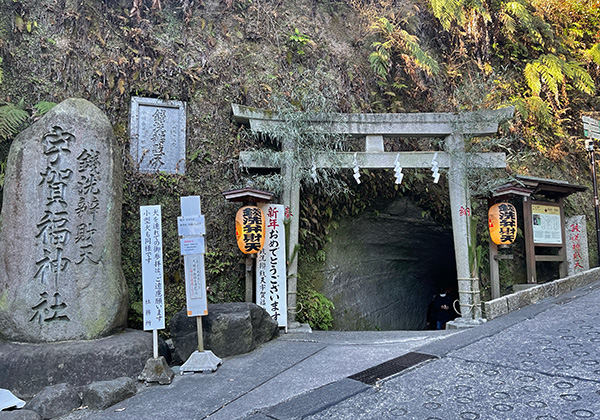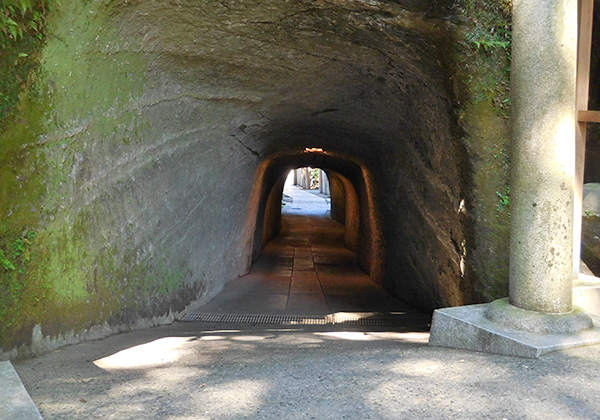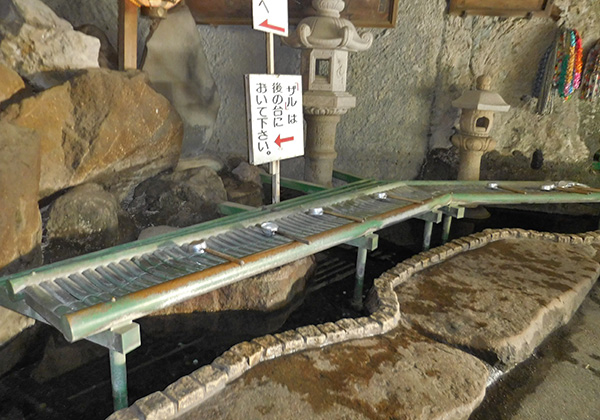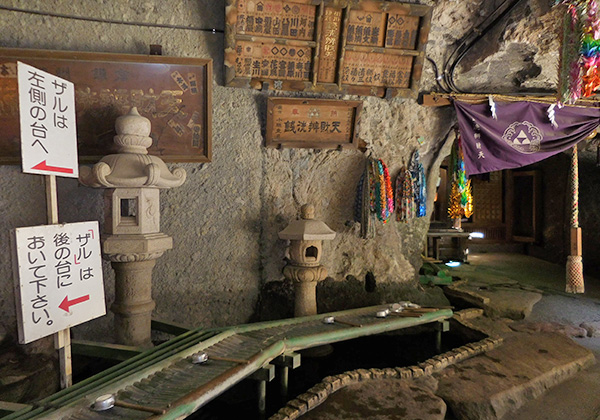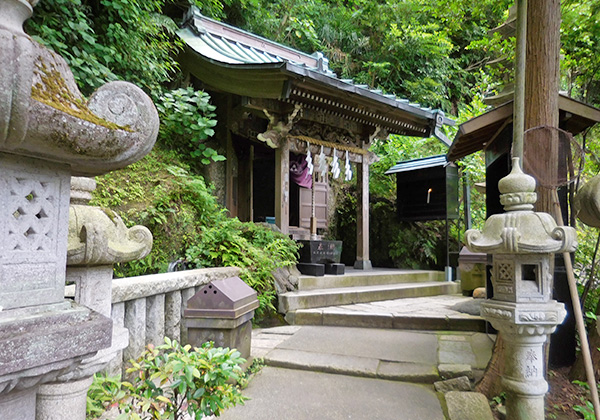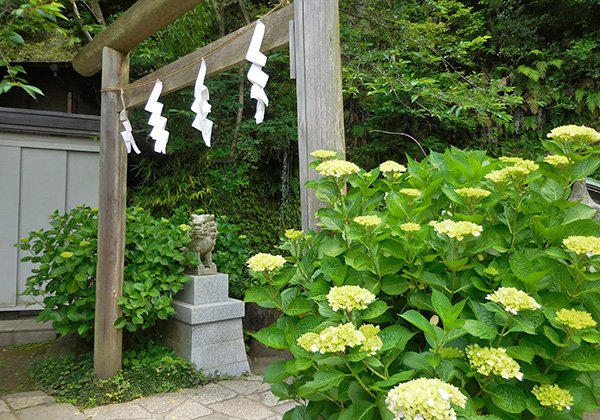Zeniarai Ugafuku Jinja
| Official Name | Zeniarai Ugafuku Jinja (Pronounced zeh-nee-ah-rye woo-gah-foo-koo gin-jah}. Popularly called Zeniarai Benten |
|---|---|
| Religious sect | Shinto |
| Founded | in Circa 1185 by unknown |
| Main object of worship | Folkloric deity of Ugajin or Uga-no-kami |
| Address | 5-16, Sasuke 2-chome, Kamakura, Kanagawa 248-0017 (show route from current location ) |
| Location | 1,500 meters northwest of Kamakura Station |
| Time needed to get there | 25 minutes |
| Admission | Free |
| Open | Year round |
| Phone number | 0467-25-1081 |
| Restrooms | Available |
Historical Overview
Lay people do not know whether this is a Buddhist temple or a Shinto shrine until they find a number of red torii gates as they enter the grounds. However, there is an incense burner in the courtyard and the area is fragrant with incense, which puzzles visitors and make them wonder anew if this is really a shrine.
Zeniarai Benten here used to be a sub-shrine of Yasaka Shrine in Ogigayatsu, but became independent in 1970.
According to legend, the Shrine dates from the era of Yoritomo Minamoto {yoh-re-toh-moh me-nah-moh-toh} (1147-1199), the founder of the Kamakura Shogunate. One night after a series of battles, an old man appeared in his dream and said "I am the god of Ugajin {woo-gah-gin}. There is a spring in the gorge located in the northwest direction of Kamakura. Go find it and worship Ugajin with the spring water. People may start to have faith in the god and peace will be restored." It was the day of the Serpent, the month of the Serpent in 1185, the year of Serpent on lunar calendar based on twelve zodiac signs.
Yoritomo interpreted the dream as a divine revelation and immediately made his men find the spring and they located it at the site where the present-day Shrine stands. He ordered to dig a cave and enshrine the god of Ugajin. Uga means food and jin is god, and therefore, Ugajin is the god of food or the god of grain to be exact. Praying to the god of Ugajin for a bumper crop, farmers near here washed rice seeds with this spring water. Later, Ugajin began to be worshiped as the God of Wealth and was assimilated with Benzaiten {ben-zye-ten} (Sarasvati in Sanskrit), the Goddess of Fortune. Sarasvati is a divinized river in Brahmanism and revered as the God of Water. The Shrine, therefore, demonstrates a syncretism in Japanese religions combining a Shinto god with a Buddhism deity through the common element of water. The torii gates and the incense burner indicate a reconciliation of Shinto and Buddhist elements. The object of worship enshrined here is the statue of a serpent with a human head made of stone (andesite) brought from the Izu (e-zoo) Peninsula. A serpent is supposed to be sacred to Benzaiten. However, it is not viewable to visitors as enshrined deep inside the cave. The snake statue reminds me of Zombie of voodoo cult, but the one here does not have a supernatural power to reanimate a dead body but may hopefully make worshipers a little bit richer. (For your reference, a statue of Ugajin is viewable at Kaizoji. It has a human head on a coiled serpent and is enshrined in the cave near the main hall.)

Zeni-arai or Coin-Washing

It was not until 1257, however, that the unique coin-washing practice started. Tokiyori Hojo {toh-kee-yoh-re hoh-joe} (1227-1263), then the Fifth Regent, visited the Shrine one day and washed his coins with spring water, saying that coins washed here might be doubled. Hearing this, people began to wash their coins, and since then coin-washing practice has been honored by many people in the hope that they would get rich. Hence the Shrine is credited by the superstition with the power of enrichment. Today, people visit here almost uninterruptedly making it one of the most busy shrines in Kamakura. Meanwhile, Zeni means coins and arai washing.
The Shrine's grounds are surrounded with rocks, and there is a cave in the rear where water is pooled. The water is coming from the said spring deep inside the cave, which is counted as one of the Five Noted Wells in Kamakura. The cave is lit with numerous candles. Bamboo baskets and ladles are available on the shelf. Most visitors are busy washing their paper money, not coins. Perhaps, they hope the larger the amount, the greater the benefit.
With this peculiar custom, the Shrine is widely known in Japan. Tens of thousands visitors repair to the Shrine wishing to get wealthy. When I visited here for the first time, it was my impression how greedy they were wishing to get rich without any cost or perspiration. The greedier the visitors, the larger the bill they wash. In ancient days, however, people were living in dire poverty. No matter how hard they worked, they were unable to be rich, and all they could do was to pray to god, washing pennies here and wishing they would double. That's understandable, but today's people are not as poor.
On second thought, however, I realized that most visitors are washing their money just for fun or on a whim. Obviously, they do not believe washing money will make them rich. Some say, "Wash money with sacred water and spend it clean". It's money laundering in the Japanese fashion. Oddly enough, two-thirds of those who visit here are women, according to a survey conducted by a magazine publisher. Dose it mean that women are greedier than men?
On the other hand, there are a handful of devout worshipers, mostly merchants, who deeply revere the Shrine and wash bundles of 10,000-yen (roughly US$90) bills. (As noted above, zeni means coins, not paper money.) In fact, hundreds of torii gate appearing near the entrance of the Shrine were donated by those merchants who believe their wealth was brought by virtue of the power of Ugajin here. Those merchants come visit here every month on the Day of Serpent by all means to attend the rituals held by the Shrine. Police warns car-drivers not to drive into the neighborhood on weekends and the Serpent Days. Most crowded is the first Serpent Day of the year, which usually falls on early February days and Benten Festival takes place.
Today, Kamakura Station sells tickets by coin-operated machines. A couple of decades ago when tickets were sold by hands, wet notes were plastered on the window glasses of the Station office. Those were money washed at the Shrine and visitors bought tickets with the wet money. Today's machines, however, do not accept wet bills.
Foreign visitors probably feel curious about the eggs sold at the souvenir shops inside the Shrine. The Shrine deity is sacred to the Serpent and the favorite food of serpent are eggs. Dedicating the eggs to the deity, they pray their wishes be answered.
